The Intricacies of Sandfish Skimboarding Explored
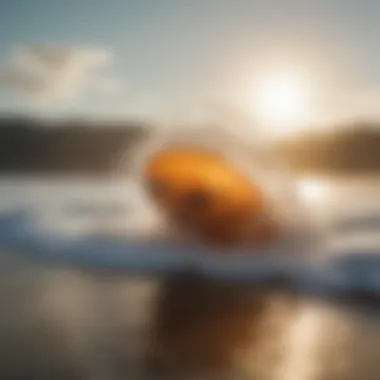
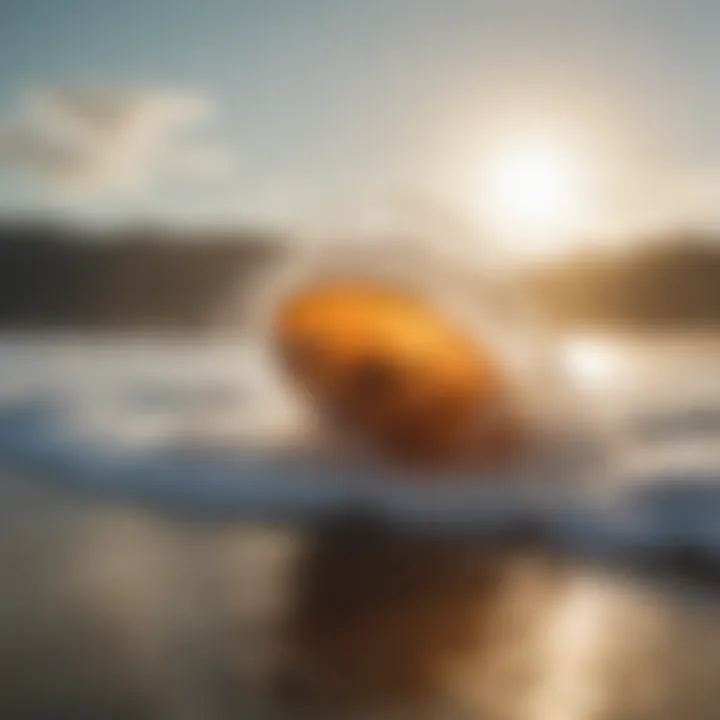
Intro
Sandfish skimboarding, often overlooked in the realm of watersports, presents an intriguing blend of skill, culture, and sheer exhilaration. As you stand at the water's edge, watching riders glide over the surface, it becomes clear this isn't just a playful pastime. It’s an activity that connects people to their environment and to one another, as well as a platform for self-expression. The pantheon of skimboarding enthusiasts range from those just trying it for the first time to seasoned riders executing breathtaking tricks, all sharing a common passion for the thrill of skimboarding on sandy shores.
This article aspires to shine a spotlight on the multifaceted world of sandfish skimboarding. From foundational techniques to advanced skills, gear essentials, and safety measures, this narrative invites everyone—novices and veterans alike—into the vibrant community that defines this active sport. Learning about sandfish skimboarding goes beyond techniques; it's about understanding how it shapes our interaction with coastal environments and the cultural significance it holds in various communities.
Let’s dive into the core elements of this dynamic sport, exploring the practices that make skimboarding a unique pastime and examining what to expect in your journey through the sands.
Prelims to Sandfish Skimboarding
Skimboarding, particularly in the context of sandfish skimboarding, has really carved out its niche in the larger landscape of water sports. The way it dances between land and sea offers not just a thrill but also a deeper connect with nature. Understanding the nuances of this sport isn't just about learning to skim across the surface of the water; it’s about appreciating the intricate balance between skill, environment, and culture.
Definition of Skimboarding
Skimboarding is a unique sport that involves gliding or skimming across the surface of the water on a board, typically from a sandy beach to the water and back again. Picture this: you run towards the shoreline, your board underfoot, and with a swift motion, you launch yourself across the wet sand. It's a combination of surfing and skateboarding, but with its own distinct flavor. The board, smaller than a surfboard and often made from a lightweight material, allows riders to pull off tricks and maneuvers that are as visually stunning as they are exhilarating.
Historical Evolution of Skimboarding
Skimboarding is not exactly a new kid on the block; it has a history that stretches back several decades. The origins can be traced to the early 20th century, when young surfers in California crafted their own wooden boards to catch waves and ride back to the shore without getting their feet wet. This simple yet ingenious idea morphed over the years as boards became more sophisticated — from the wooden models of yore to the high-tech fiberglass and composite boards available today.
In the 1970s and 80s, skimboarding took off in popularity, particularly in southern California beaches like Laguna Beach and Malibu. As it grew, so did its community, evolving from a local pastime to an international sport that attracts enthusiasts from across the globe.
Many modern skimboarders owe a nod to pioneers like Tom Shearer and others who contributed to the sport's evolution, devising innovative techniques and designs. Nowadays, skimboarding not only takes center stage in local competitions but has a vibrant presence on social media, connecting a global community of enthusiasts.
"Skimboarding is more than just a sport. It’s about the connections we make and the balance we achieve with nature.”
Understanding both the definition and the history of skimboarding brings context to its appeal. Whether you’re a beginner or a seasoned pro, there's so much richness to explore in the world of sandfish skimboarding. The sport is not merely about the thrill of the ride; it encapsulates an evolution marked by the passion of its community, paving the way for future generations to chase the waves and catch the sand.
The Unique Appeal of Sandfish Skimboarding
Sandfish skimboarding is not just another watersport; it embodies a unique blend of thrill, strategy, and an undeniable connection to nature. Unlike surfing or wakeboarding, skimboarding allows individuals to glide along the wet sand, creating a fusion of speed and skill. Its charm lies in the simplicity and accessibility—anyone, from a curious novice to a seasoned athlete, can enjoy it. Moreover, the artistry involved in executing maneuvers on this medium amplifies its appeal.
Natural Environment and Conditions
The environment plays a crucial role in shaping the skimboarding experience. Sandfish skimboarding thrives where sandy beaches meet shallow waters, ideally under warm sunlight. Locating the right spot can be a game changer, as the ideal conditions must align:
- Steady, flat beaches allow for smooth rides and efficient gliding.
- Incoming waves provide momentum, making the act of launching much easier and more exciting.
- Tides are also a critical consideration. A tide that is just right will provide a perfect wet sand area that enhances speed and control, aiding in each ride.
When surfers may seek the thrill of waves, skimboarders relish the embrace of the beach. For instance, some of the best locations for sandfish skimboarding include Laguna Beach in California, where the waves come rushing close to shore, or Cape Cod, where early morning tide presents pristine conditions.
Cultural Influences on the Sport
Sandfish skimboarding is deeply intertwined with various cultural elements that shape its practice and community. It reflects a lifestyle marked by creativity and a strong sense of camaraderie. This sport has roots in coastal communities, where local influence can be seen through the adoption of diverse styles and techniques.
- Community Gatherings: Skimboarding events and competitions often serve as social hubs, bringing people together. These events not only showcase talent but tend to foster friendships among participants and spectators.
- Influence of Local Styles: Different regions develop unique skimboarding styles based on local culture. In some coastal areas, tricks are blended with regional music, turning routine skimboarding into a vibrant expression of local pride.
- Online Communities: Platforms like Reddit and various Facebook groups dedicated to skimboarding allow enthusiasts to share tips, experiences, and support each other's progress. These digital forums contrast with traditional gathering spots, expanding the sport’s cultural reach beyond physical boundaries.
"Sandfish skimboarding isn't merely about the ride—it's about building connections and sharing experiences with fellow enthusiasts, both on and off the beach."
As the sport grows in popularity, these cultural threads weave together, creating a rich tapestry that continually evolves. The interplay between the environment and the culture adds layers to the already compelling nature of sandfish skimboarding, making it an exciting pursuit for those who dare to skim.
Essential Gear for Sandfish Skimboarding
When stepping into the world of sandfish skimboarding, having the right equipment is essential. Just like a carpenter wouldn't show up to a job without their tools, a skimboarder needs specific gear to fully enjoy and excel in the sport. This section highlights essential elements, their benefits, and important considerations regarding the gear one should consider for a vibrant skimboarding experience.
Types of Skimboards
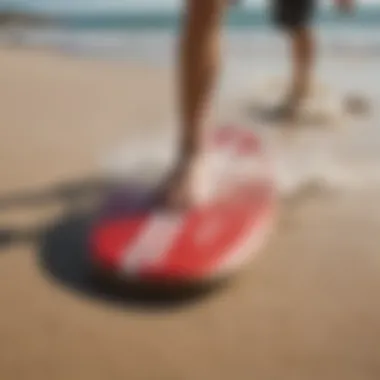
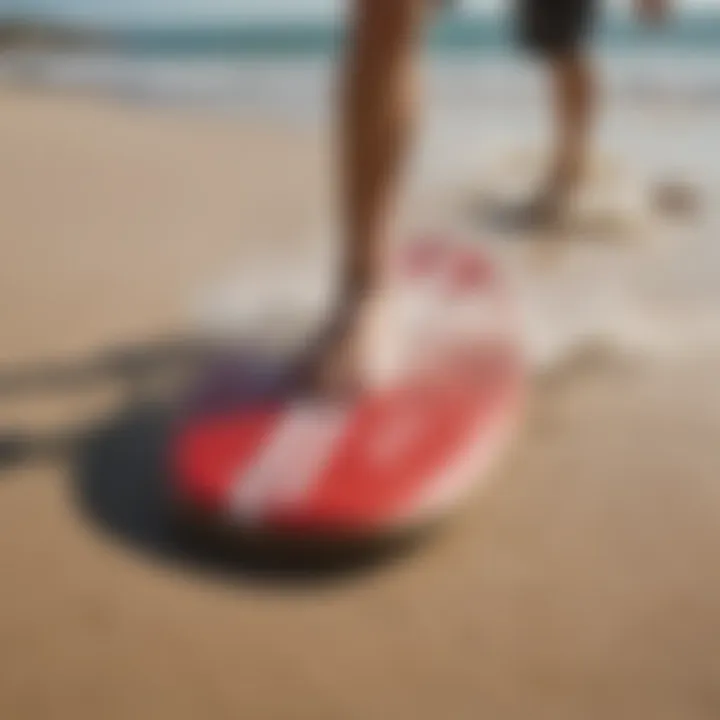
Choosing the right skimboard is paramount to your performance on the sand. Skimboards come in various shapes and materials, each designed for specific conditions and styles. The key types include:
- Wooden Skimboards: Often heavier and more durable, they provide added stability, making them great for beginners. They are usually less expensive and perfect for those learning the ropes.
- Epoxy Skimboards: These boards are lighter, faster, and more buoyant compared to wooden ones. Epoxy skimboards are ideal for advanced riders looking to perform tricks and maneuvers. They also offer better glide on the surface, which can be a game changer in competition.
- Polymer Skimboards: A mix of the two, polymer boards tend to be versatile, combining the buoyancy of epoxy with the sturdiness of wood. They can adapt well to a variety of conditions.
"The right type of skimboard can make all the difference between a thrilling ride and a frustrating tumble."
Safety Equipment and Accessories
While the thrill of skimboarding often steals the spotlight, safety should never take a back seat. Therefore, investing in safety equipment is just as crucial as selecting the right board. Here are some accessories to consider:
- Helmet: Protecting your head should be a top priority, especially when you’re just starting out. Slips and falls can happen to anyone, and a well-fitted helmet can prevent serious injuries.
- Wetsuit: Depending on the water temperature and location, a wetsuit can keep you warm and comfortable while you navigate the waves. Look for options that offer protection against abrasions.
- Rash Guard: Useful in warmer waters, a rash guard can prevent chafing from the board while also offering some UV protection.
- Water Shoes: These not only protect your feet from sharp objects on the beach or in the water but also help you gain better traction when running for your ride.
Besides protective gear, it’s wise to carry along a first-aid kit for minor accidents during your skimboarding sessions. Always be prepared, so you can focus on enjoying the waves rather than worrying about potential mishaps.
Techniques and Skills in Sandfish Skimboarding
The sport of sandfish skimboarding is not simply about gliding across the shoreline; it heavily relies on mastering various techniques and skills that can significantly enhance one’s experience. Learning the nuanced aspects of skimboarding can amplify one's connection to this exciting activity while fostering personal growth in both technique and confidence. Regardless of whether you're just dipping your toes in or you've been skimming like a pro, knowing the right techniques can be the difference between a gleeful ride and a tumble in the sand.
Basic Techniques for Beginners
For those who are just starting, grasping the basic techniques is fundamental in establishing a solid foundation. First things first, let's talk about the stance. Positioning oneself correctly can be the linchpin for executing moves properly. The ideal stance is with knees slightly bent, feet shoulder-width apart, and your weight evenly distributed. This reduces the chances of losing balance.
Another essential technique is the running and launching method. Before attempting to ride the skimboard, practice the run-up. A strong, controlled sprint helps build momentum. As you reach the shoreline, aim to place the board on the water surface with a smooth transition, keeping it at a slight angle.
Additionally, the drop technique deserves significant attention. The key is to simply let the board drop into the water rather than forcing it. A gentle drop not only preserves board integrity but also allows a smoother gliding experience. Here below are a few more key points:
- Foot Placement: Ensure your back foot is positioned close to the tail of the board.
- Weight Transfer: Shift your weight seamlessly between feet as you ride, enhancing balance.
- Practice the Fall: Learning how to fall correctly can minimize injuries, rolling away from the board rather than landing flat.
When practicing these basic skills, remember that patience is key. It might take a handful of tries before everything clicks.
Advanced Maneuvers and Tricks
Once the basics have been mastered, many enthusiasts start looking towards advanced techniques to elevate their skimboarding. These maneuvers not only showcase one's skill but also inject a thrilling element into the sport.
The pop-up maneuver is often the first trick skimboarders aim to learn. This involves springing off the board while in motion to create a small jump off the water surface. Timing and body control are critical here; practicing it in low-tide conditions can be beneficial. The 360 spin is another desirable skill, where the skimmer executes a full rotation while skimboarding. Proper weight shifting and a robust commitment to the spin will be crucial for success.
In addition, tricks such as the slip and slide or the board grab necessitate agility and sharp reflexes. The slip and slide requires sliding the board back while ensuring your feet remain on it, whereas the board grab adds flair by allowing riders to grab the board mid-air.
“As you progress into advanced tricks, remember, safety should always be your top priority—wearing a helmet is wise.”
Here’s a summary of some advanced maneuvers:
- Pop-Up Maneuver: Jump off the water, landing back on the board.
- 360 Spin: Rotate your body in a full circle while gliding.
- Slip and Slide: Control your board on the water surface as your feet remain planted.
- Board Grab: Reach down to grab the board while executing a trick.
As tempting as it may be to rush through these tricks, methodical practice will yield the best results.
Mastery of techniques and skills in sandfish skimboarding not only enhances performance but deepens the sense of belonging to the vibrant community surrounding the sport. Rather than just surviving the waves, with the right know-how, riders can thrive in this dynamic water activity.
Skimboarding Locations and Conditions
Choosing the right spot for sandfish skimboarding can literally make or break your day at the beach. The dynamics of this sport hinge not only on personal skill but also heavily depend on location and environmental conditions. A good skimboarding site should provide a perfect blend of sand quality, wave action, and a safe area for both beginners and seasoned pros. This section elucidates how the right conditions enhance the skimboarding experience, enabling participants to enjoy this water sport to its fullest.
Identifying Ideal Spots
To find the ideal skimboarding spot, enthusiasts need to consider several factors. First off, the sand composition is crucial. Fine, compact sand allows for smoother rides and better control. Areas that have a soft, loose sand can slow down the board and makes it tricky for those trying to pick up speed.
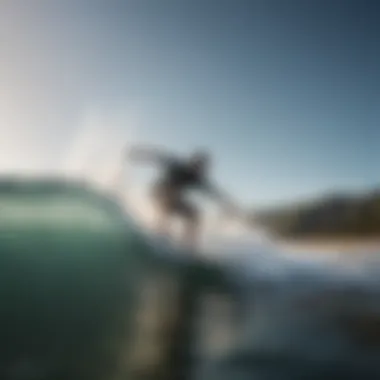
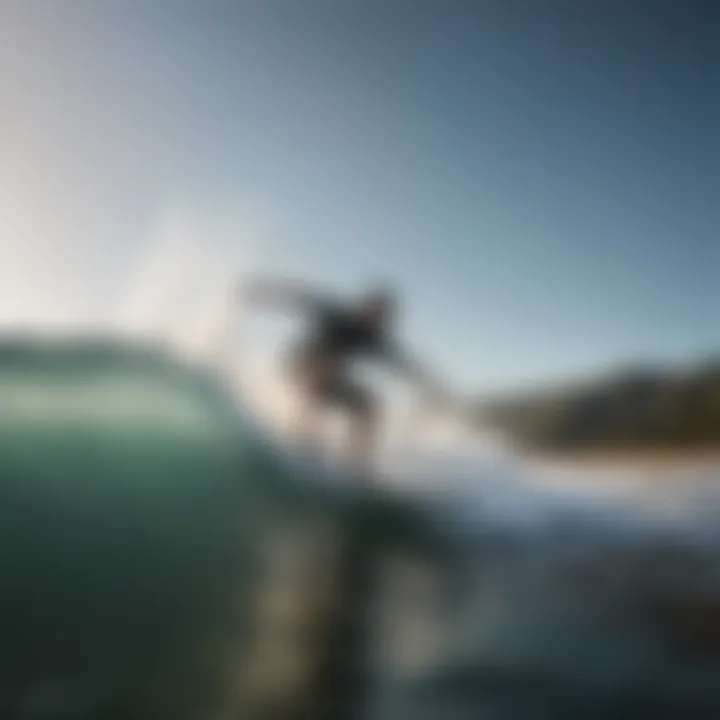
The water levels also matter. Shallow waters are generally preferred as they minimize the risks of injury. Look for locations where the tide recedes, creating a flat stretch of wet sand, often referred to as the 'skim zone.'
Here’s a simple rundown of features to spot the best skimboarding beaches:
- Sheltered Corners: These areas provide protection from strong winds and rough waves.
- Consistent Wave Size: Look for locations with manageable waves, not too huge but not nonexistent either.
- Nearby Amenities: Access to restrooms and parking can make a big difference in the overall experience.
Understanding Tides and Weather Patterns
Tides and weather can shift the tides of a skimboarding session, quite literally. Knowledge of local tide schedules helps determine when the beach will be at its most accessible. Generally, skimboarders flock to the beach just before high tide or during low tide, taking advantage of the rapidly changing water levels.
Weather conditions, too, should tip the scales in your planning. Even a light rain can change the texture of the sand and alter how the board glides. Not to mention the wind – while some may ride with the breeze at their back, others may find a strong headwind to be quite the nuisance.
To maintain optimal safety and enjoyment levels:
- Check Local Tide Charts: Knowing when the tides are in and out is key.
- Monitor Rain and Wind: Keeping an eye on the forecast can prevent harsh surprises.
- Observe Conditions Daily: The ocean is unpredictable; what worked yesterday may not work today.
"One might call skimboarding an art, where the canvas is the beach and the brush strokes are made with finesse by skimming along the water."
Staying tuned to these factors not only enhances performance but also encourages responsible enjoyment of natural settings, thus promoting a sustainable culture among skimboarders. Understanding and preparing for the dynamics at play helps translate into a more fulfilling skimboarding experience.
Environmental Considerations in Sandfish Skimboarding
Sandfish skimboarding is not just a thrilling water sport; it also comes with significant responsibility towards the environment. Understanding its environmental considerations helps participants appreciate the natural ecosystems that host this activity. By delving into how skimboarding impacts coastal ecosystems and the sustainability practices within the sport, we can take steps to preserve these beautiful settings for generations to come.
Impact on Coastal Ecosystems
When discussing sandfish skimboarding, the first thought might not be its ecological effects. However, the reality is that every board slide and splash has a ripple effect on the coastal environments where the sport occurs. Skimboarding tends to be popular on beaches, which are fragile ecosystems.
- Disturbance of Dune Systems: When skimboarders engage in their sport, they can inadvertently disturb sand dune systems. These dunes play a vital role in stabilizing coastlines and providing habitat for various wildlife.
- Impact on Wildlife: Coastal areas are home to numerous species, from nesting birds to marine life. Skimboarding can disrupt their natural behaviors. For instance, seabirds may abandon their nests when coastal areas are too crowded or noisy.
- Erosion Concerns: The physical act of skimboarding can contribute to erosion, particularly if the activity occurs in the same area repeatedly. This can lead to the degradation of the shoreline.
It’s crucial that skimboarders acknowledge these impacts. Engaging in responsible practices not only helps preserve the environment but also ensures that the sport can continue to thrive amid nature’s beauty.
Sustainability Practices in the Sport
Sustainability has become a buzzword in many outdoor activities, and sandfish skimboarding is no exception. Having fun while being environmentally conscious can go hand in hand. Here are some practices that not only protect the coastlines but can also enhance the skimboarding experience:
- Leave No Trace: Participants should follow the Leave No Trace principles. This includes packing out what you pack in, so the beach remains unspoiled for others and wildlife.
- Choose Eco-Friendly Gear: There are a growing number of brands that focus on sustainable materials for skimboards. Opting for boards made from recycled materials can make a significant difference.
- Stay In Designated Areas: Confining skimboarding activities to designated areas can minimize the impact on more sensitive ecological zones. This is where local regulations can come into play, especially during nesting seasons or in highlighted conservation zones.
- Engaging in Restoration Activities: Communities often organize beach clean-ups and restoration efforts. Active participation in these events can foster a sense of community and responsibility among skimboarders.
- Educate Others: If you’re an experienced skimboarder, consider sharing knowledge about the importance of environmental stewardship with newcomers. The future of the sport depends on it.
"Respect for nature is not just an idea but a necessity for the survival of both the sport and the ecosystem that supports it."
The Community and Culture of Sandfish Skimboarding
Sandfish skimboarding isn't just about racing across the sand and catching waves; it's very much a community-driven sport. The intertwined nature of friendships and shared experiences deepens one’s connection to this water-based activity. Engaging in skimboarding creates a social fabric that binds enthusiasts together, providing both a support system and a platform for exploring creativity in the sport.
Being part of a skimboarding community helps build skills and fosters a sense of belonging that transcends geographical boundaries. Beyond personal gain, there's also an element of collective growth as individuals motivate one another. Whether you’re the kind of person who prefers the mellow vibe at the beach or someone driven to push boundaries, the culture surrounding skimboarding has something for everyone.
Local and Global Skimboarding Communities
Local communities form the bedrock of sandfish skimboarding culture. In many coastal towns, you can find passionate skimboarders who frequently meet at popular spots. Joining these gatherings not only improves your skills but also lets you swap stories of triumphs and tribulations. In smaller locales where everyone knows each other, this social engagement spurs camaraderie that's hard to replicate elsewhere.
On the flip side, global communities, often established through platforms like social media or websites, help enthusiasts connect across distances. They share tips, tricks, and even video clips demonstrating different techniques. Websites like reddit.com allow for vibrant discussions about gear, tricks, and experiences, strengthening the bond of the sport on a worldwide scale.
Key Features
- Workshops and Training Sessions: Many local communities host workshops that teach everything from the fundamental basics to advanced tricks. These events allow newcomers to learn from veterans and ask questions in a casual environment.
- Online forums and Groups: Platforms like facebook.com and reddit.com provide spaces where discussions flourish about techniques, gear, and personal anecdotes.
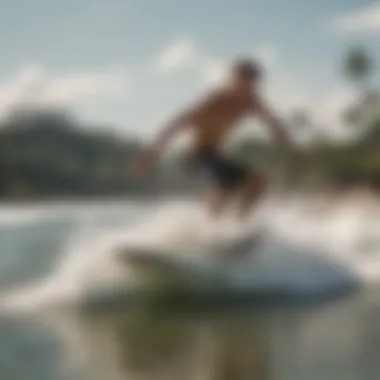
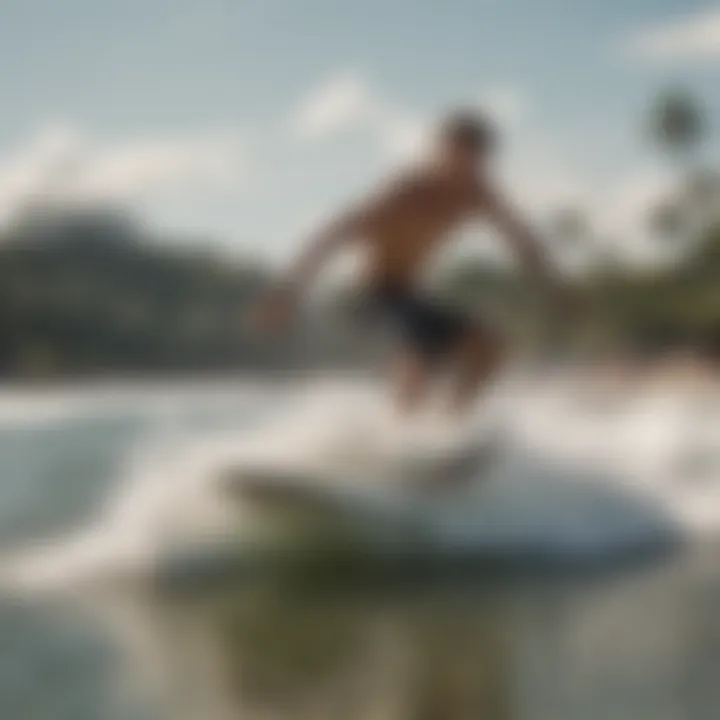
Competitions and Events
Competitions in sandfish skimboarding bring out the best in athletes while showcasing the spirit of collaboration. Local contests often grow from small gatherings into significant events that draw participants from numerous regions, giving everyone a chance to shine. Here, a sense of healthy competition fosters skills development, with participants pushing one another to perform at their best.
Events like the Sand and Surf Festival or regional championships serve as platforms for aspiring skimboarders to showcase their styles. These gatherings not only retain a competitive edge but also promote a shared love for the sport among the spectators.
"Competitions are about growth, not just glory. The more you challenge yourself, the more you learn."
Several aspects denote the vibrancy of these competitions:
- Diverse Categories: Competitions may range from technical trick categories to free ride events, catering to a wide range of skills and styles.
- Camaraderie Among Competitors: Participants often cheer for one another, emphasizing that despite rivalries, the sport promotes unity.
Enthusiasts have the wonderful opportunity to connect and grow both locally and globally, enriching their experience on and off the board.
Future Trends in Sandfish Skimboarding
As the world continues to evolve, so does the realm of sandfish skimboarding. The significance of discussing future trends encompasses not only advancements in gear and techniques but also the broader implications these trends hold for the skating community and coastal environments. Enthusiasts and newcomers alike can glean valuable insight into how innovations might shape their experiences on the sand and surf.
Innovations in Equipment
In recent years, we’ve seen a notable shift in the materials and designs used in skimboarding equipment. Manufacturers are beginning to prioritize lightweight materials that offer durability without compromising performance. For example, modern boards are often crafted from composite materials like carbon fiber or reinforced plastics, which significantly enhance speed and agility.
Benefits of New Equipment Technology
- Enhanced Performance: Lighter boards mean longer rides and quicker maneuvers, allowing riders to perform complex tricks with more ease.
- Improved Durability: Many of the newer materials are built to withstand the harsh conditions experienced on beaches, enhancing longevity and value.
- Eco-Friendly Options: Some brands are now focusing on sustainability, producing boards from recycled materials or ones that reduce the environmental impact of manufacturing.
As these developments unfold, it's vital to keep an eye on how they influence the overall skimboarding experience. Practitioners need to adapt not just to the equipment itself, but to the accompanying community culture that celebrates these innovations.
Evolution of Techniques and Styles
The techniques associated with sandfish skimboarding have also undergone significant transformation. While traditional methods focused primarily on riding and stability, there is a growing trend towards more complex and daring maneuvers. Today's skimboarders are experimenting with a blend of skating styles and surf tricks, lending a fresh energy to the sport.
Part of this evolution stems from the influence of the broader action sports culture, where cross-pollination of skills and styles occurs regularly. Riders are beginning to blend elements from skateboarding and surfing, offering a dynamic viewing experience for onlookers and a new challenge for practitioners.
Key Techniques Shaping the Future
- Power Slides: More advanced riders are incorporating power slides, which involve shifting weight while maintaining speed, allowing for impressive stops and turns.
- Aerial Tricks: Jumping off of small ramps or natural terrain features to perform aerial tricks has become increasingly popular, promoting creativity and individual style.
- Carving Turns: Mastering the art of carving turns, or sharp directional shifts, enhances control and flow during a run.
"As skimboarding continues to grow, the fusion of different techniques not only elevates the sport but also creates a sense of community among riders who are eager to share their innovations."
The End: The Ongoing Journey of Sandfish Skimboarding
In a sport like sandfish skimboarding, the essence of the experience goes far beyond the physical acts of gliding and tricking on the shore. The culmination of techniques, community, and personal growth intertwines to craft a significant journey for all enthusiasts, regardless of their level of expertise. Through the information presented in this article, it becomes clear that sandfish skimboarding isn't merely about catching waves on a skimboard; it’s about embracing a lifestyle that encourages individual development and connection with nature.
Revisiting the various elements discussed, the importance of the sport manifests in numerous ways. From learning the foundational skills to understanding the environmental responsibilities that come with it, every skimboarder has a unique narrative that contributes to the evolving culture of the sport. Skimboarding is not just a recreational activity; it’s a pathway to self-discovery, fostering resilience and creativity, while generously allowing participants to explore their limits.
Moreover, as the sport continues to innovate through equipment advancements and technique evolutions, it remains essential to nurture a mindset geared towards growth. Each ride on the sand grants an opportunity to learn something new, to redefine one’s goals, and to celebrate every progress made along the way. Ultimately, this ongoing journey encourages everyone to immerse themselves in the world of sandfish skimboarding, rekindling their passion and engaging in lifelong learning.
Reflecting on Personal Growth in Skimboarding
The journey of sandfish skimboarding is intricately tied to personal transformation. For many, stepping onto a skimboard is the first taste of overcoming fear and doubt. As skimmers ride across the shimmering sands, they face challenges that push their boundaries. Every wipeout teaches resilience; every successful glide fosters confidence. This continuous cycle of trial and error can serve as a microcosm of life’s journey.
In practice, individuals often discover hidden strengths as they conquer challenging tricks or learn to read the waves more effectively. While initially daunting, the sport cultivates an unspoken camaraderie among riders, offering a solid support system that bolsters personal growth. Learning to celebrate small victories—like nailing a new trick or smoothly navigating tricky conditions—instills a sense of accomplishment that permeates other areas of life. It becomes a way to embrace a mindset that values improvement over perfection.
Encouragement to Explore and Experiment
As skimboarding enthusiasts gather along sandy shores, it's vital to encourage exploration and experimentation—two core driving forces behind personal and communal growth in the sport. Trying out various techniques or innovative tricks can invigorate one's experience, opening doors to new skills and styles. Fresh perspectives often lead to exhilarating breakthroughs, transforming a simple skimboarding session into a memorable adventure.
Dare to venture into new skimboarding venues, each with its own unique conditions and aesthetics. Different beaches offer the thrill of adapting to varying tidal patterns, sand textures, and even weather. Trying out different boards or safety gear can also enhance comfort and performance. As you immerse yourself in new experiences, don’t hesitate to document your journey. Sharing stories and insights with fellow skimming enthusiasts not only nurtures community bonds but also inspires others to take the plunge into their evolving journeys.
In summary, sandfish skimboarding represents an incredible opportunity for growth and connection. By embracing the journey and allowing yourself to explore, you can create cherished memories and cultivate a deeper appreciation for the dynamic sport.















